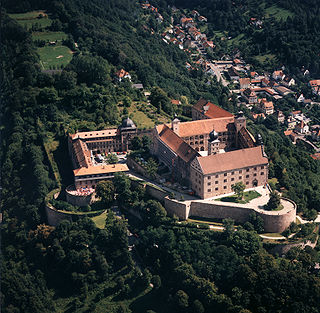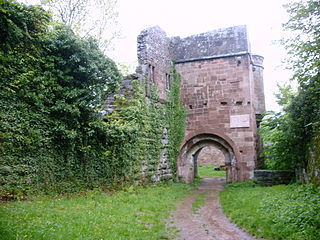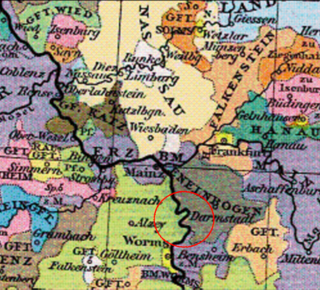
Burgrave, also rendered as burggrave, was since the medieval period in Europe the official title for the ruler of a castle, especially a royal or episcopal castle, and its territory called a Burgraviate or Burgravate.

Plassenburg is a castle in the city of Kulmbach in Bavaria. It is one of the most impressive castles in Germany and a symbol of the city. It was first mentioned in 1135. The Plassenberg family were ministerial of the counts of Andechs and used as their seat the Plassenburg. The House of Guttenberg, a prominent Franconian noble family, traces its origins back to 1149 with a Gundeloh v. Blassenberg (Plassenberg). The name Guttenberg is derived from Guttenberg and was adopted by a Heinrich von Blassenberg around 1310. From 1340, the Hohenzollerns governed from Plassenburg castle their territories in Franconia till 1604. The Plassenburg was fortress and residence for the Hohenzollerns.

Burg Stargard is a small town in the Mecklenburgische Seenplatte district, in Mecklenburg-Vorpommern, Germany. It is situated 8 kilometres (5.0 mi) southeast of Neubrandenburg.

Sommeregg is a medieval castle near Seeboden in the Austrian state of Carinthia, Austria. It is situated in the foothills of the Nock Mountains at an altitude of 749 m.

Herren von Graben, also named von (dem) Graben, vom Graben, Grabner, Grabner zu Rosenburg, Graben zu Kornberg, Graben zu Sommeregg, Graben von (zum) Stein, and ab dem Graben was the name of an old (Uradel) Austrian noble family.

Frederick II von Graben, also called Frederick the Younger, was a Styrian noble, a member of the edelfrei Von Graben family. He held the titles as Lord of Kornberg and Marburg, the Lordship Marburg as well as burgrave of Riegersburg. One of the most affluent Styrian nobles, Frederick was an advisor to the Habsburg emperor Frederick III, where he held a special position, assessor at the Reichskammergericht, and member of the duchy's Landtag assembly.

Ulrich II von Graben was a Styrian noble, a member of the edelfrei Von Graben family. He held the titles as Lord of Kornberg and Graben Castle, as well as burgrave of Gleichenberg, Rothenfels and Hohenwang.
The Dohna Feud was a 14th-century dispute between the burgraves of Dohna, who resided in the Eastern Ore Mountains of Central Europe, on the one hand and Saxon nobleman, John of Körbitz and the Meißen Margrave William I on the other. The feud lasted from 1385 to 1402.

Hohnstein Castle is a medieval castle in the village of the same name, Hohnstein in Saxon Switzerland in the Free State of Sachsen in East Germany.

Dohna Castle on the once important medieval trade route from Saxony to Bohemia was the ancestral castle seat of the Burgraves of Dohna. Of the old, once imposing double castle only a few remnants of the walls remain. The ruins of the old castle are located on the hill of Schlossberg near the subsequent suburb of the town of the same name, Dohna, in the district of Sächsische Schweiz-Osterzgebirge in Saxony, Germany.

The hunting lodge of Augustusburg was built from 1568 to 1572 above the town of the same name on a hill called the Schellenberg on the northern edge of the Ore Mountains of Germany. The castle, which is visible from afar, is a local landmark. It lies about 12 kilometres east of the city of Chemnitz and about 21 kilometres southwest of Freiberg in the Free State of Saxony.

Satzung is a village in the Saxon municipality of Marienberg, which is in the district of Erzgebirgskreis in the German Ore Mountains.

Mildenstein Castle, in German Burg Mildenstein, also called Schloss Leisnig, is located in Leisnig in Landkreis Mittelsachsen, Saxony, Germany. It is a property of the Free State of Saxony and is administrated by the company State Palaces, Castles and Gardens of Saxony.

The ruins of Trutzeltz Castle, also known as Balduineltz, Baldeneltz or Neueltz, are the remains of a hill castle in the valley of the Elz in the parish of Wierschem near the town of Münstermaifeld. It was built as a counter-castle during the medieval Eltz Feud in the Moselle region.

Buch Abbey, in German Kloster Buch, is a former Cistercian monastery near Leisnig in Saxony.
Niederlauterstein is a village in Saxony which has been incorporated into the town of Marienberg in the district Erzgebirgskreis since 1996.

Wildenberg Castle, also called the Wildenburg, is a ruined, Hohenstaufen period castle in the Odenwald hills in Germany. It is located in the parish of Preunschen in the municipality of Kirchzell, in the Lower Franconian district of Miltenberg in Bavaria.

Otto Carl Alfred Moschkau (1848-1912) was a German philatelist and local historian. In 2021 he was retrospectively named as one of the fathers of philately.

The Lordship of Franckenstein was a historical territory in the northern Odenwald. It originated around 1230 from the possessions of the Breuberg, whose center was Frankenstein Castle. Konrad II of Breuberg and his wife Elisabeth of Weiterstadt called themselves Frankenstein after having build the castle henceforth. The dominion remained as condominium in the possession of the family until the year 1662. After the sale by the Frankensteis to Landgrave Louis VI, Landgrave of Hesse-Darmstadt, it came into the possession of Hesse-Darmstadt.

Seldeneck Castle is a 13th-century castle ruin near the Seldeneck residential area in the district of Blumweiler, Creglingen, Main-Tauber-Kreis, Baden-Württemberg, Germany.






















